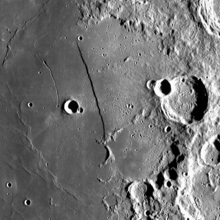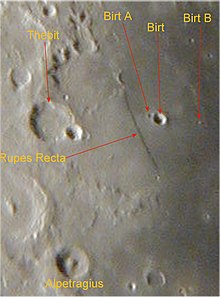This article needs additional citations for verification. (December 2009) |
Rupes Recta is a linear fault on the Moon, in the southeastern part of the Mare Nubium at 22°06′S 7°48′W / 22.1°S 7.8°W. The name is Latin for straight cliff, although it is more commonly called the Straight Wall.[1] This is the best-known escarpment on the Moon,[2][3] and is a popular target for amateur astronomers.[3][4]



When the sun illuminates the feature at an oblique angle at about day 8 of the Moon's orbit, the Rupes Recta casts a wide shadow that gives it the appearance of a steep cliff. The fault has a length of 110 km, a typical width of 2–3 km, and a height of 240–300 m. Thus although it appears to be a vertical cliff in the lunar surface, in actuality the grade of the slope is relatively shallow.
To the west of this escarpment is the crater Birt, which is about 17 km in diameter. Also to the west is the Rima Birt rille. At the southern end is a group of hills often called the "Stag's-Horn Mountains", although this name is not officially recognized by the IAU.
To the northeast is the crater Alpetragius, and to the east is Thebit.
References
edit- ^ North, Gerald (2007). Observing the moon: the modern astronomer's guide. Cambridge University Press. p. 331. ISBN 978-0-521-87407-6.
- ^ Grego, Peter (2005). The moon and how to observe it. Birkhäuser. p. 32. ISBN 978-1-85233-748-3.
- ^ a b Wood, Charles A. "The Lunar 100". Sky & Telescope. Sky Publishing. p. 2. Retrieved Feb 2, 2012.
- ^ Nathan, Steve A. "Lunar Club Observing List". Astronomical League. Retrieved Feb 2, 2012.
External links
edit- Media related to Rupes Recta at Wikimedia Commons
- "Rupes Recta", Lunar Reconnaissance Orbiter, NASA, February 9, 2011, retrieved 2012-03-27 – mosaic image of Rupes Recta from the LROC WAC.
- Wood, Chuck (January 11, 2004). "Straight Wall". Lunar Photo of the Day.
- Wood, Chuck (February 22, 2004). "More Discoveries Near the Straight Wall". Lunar Photo of the Day.
- Wood, Chuck (July 30, 2004). "Obliquely Viewed Fault". Lunar Photo of the Day.
- Wood, Chuck (April 13, 2005). "Righteous Recti". Lunar Photo of the Day.
- Wood, Chuck (November 13, 2006). "Nokia Moon". Lunar Photo of the Day. Archived from the original on June 14, 2011.
- Wood, Chuck (February 13, 2007). "New Observations of a Well-Known Area". Lunar Photo of the Day. Archived from the original on June 14, 2011.
- Wood, Chuck (February 17, 2008). "Cornucopia of Details". Lunar Photo of the Day.
- Wood, Chuck (March 7, 2009). "The Beetle". Lunar Photo of the Day.
- Wood, Chuck (August 20, 2009). "Succession". Lunar Photo of the Day.